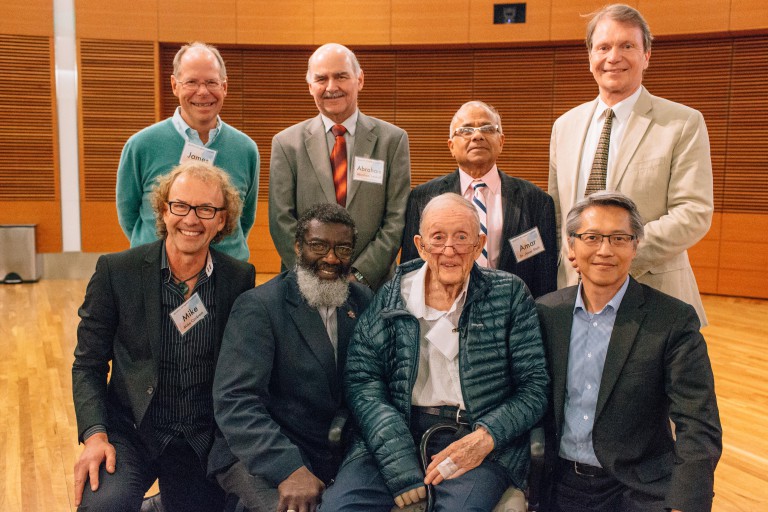Edwin Lightfoot’s academic family tree branches far beyond his Wisconsin roots. The Hilldale professor emeritus of chemical and biological engineering, who recently celebrated his 90th birthday, mentored 49 PhD students during his time on campus, 11 of whom went on to establish their own research programs at top institutions.
Recently, multiple generations of academics and CBE alumni reunited during the Ed Lightfoot symposium, held April 7 and 8, 2016, in the Discovery Building on campus. During the two days of talks and an afternoon poster session, three of Lightfoot’s distinguished former students—Bernhard Palsson, Abraham Lenhoff and James Liao—were among the key researchers who presented on topics ranging from brain diseases to biofuels—unified by the quantitative principles that Lightfoot, along with colleagues Warren E. Stewart and R. Byron Bird, set forth more than 50 years ago in the seminal text Transport Phenomena.
Transport phenomena—the principles that diverse physical, chemical and biological processes in the universe follow the same fundamental laws governing mass, energy and momentum exchange—underlie the flourishing fields of quantitative and systems biology, which use tools from the physical sciences to untangle seemingly impossibly complex biological systems and processes.
Quantitative biology, by definition, takes a cross-disciplinary approach to resolving problems in biology. The field faced an uphill battle at its outset—pessimists maintained that explaining the behavior of living cells with mathematical models was an impossible undertaking.
“People told me that trying to compute biology would be professional suicide and a dead-end career,” says Palsson (PhD ’84), the Galletti professor of bioengineering, professor of pediatrics, and the principal investigator of the systems biology research group in the Department of Bioengineering at the University of California, San Diego.
But Lightfoot always encouraged his students to be bold, pursue big ideas, and approach questions from unconventional angles.

One of Palsson’s first forays into systems biology started as a final project for Lightfoot’s class. The young student’s undertaking, which used econometric models to analyze how bacteria allocate resources during growth, went on to become a paradigm-shifting publication. “Ed got his hands on my term paper and rewrote it in such a clear and elegant way that it got into Science,” says Palsson.
Lightfoot’s former students take unique approaches to gleaning deep understanding from vast datasets. Symposium speaker Lenhoff (PhD ’84), the Allan P. Colburn professor and department chair in chemical engineering at the University of Delaware, uses information from atomic-level protein structures to predict the sometimes counter-intuitive behaviors in solutions.
Increasingly, researchers recognize that quantitating life’s processes is a powerful first step to harness them for humanity’s benefit. Mathematical models can help design living photovoltaic cells based on bacteria that store energy from the sun in the form of biological hydrocarbons, as discussed by speaker Liao (PhD ’87), the Parsons Foundation professor and department chair in chemical and biomolecular engineering at the University of California, Los Angeles, or, they can help predict the best interventions to promote wound healing, as described by Biomedical Engineering Associate Professor Pamela Kreeger.
Liao credits Lightfoot’s mentorship for defining his career. “One afternoon with Ed Lightfoot changed my life,” said Liao. “I knew nothing about biology; I was interested in polymer chemistry. He convinced me to apply control theory to the biology of metabolism.”
However, rather than effusively praise Lightfoot for his contributions to the field, speakers at the symposium instead shared lessons they learned from their former advisor.
“We learn to mentor from our mentors,” says Associate Professor and Harvey D. Spangler Faculty Scholar Jennifer Reed, who received her PhD training in bioengineering under Palsson’s advisorship, making her Lightfoot’s “academic granddaughter.”
Lightfoot’s legacy resonates in Reed’s research, which predicts complex synthetic networks based on simple information about the relative amounts of inputs and outputs in a cell. The resulting models can inform strategies for engineering bacteria to produce useful chemicals.
“(Lightfoot’s) Transport Phenomena opened my eyes to realize I could apply what I learned in physics and math to chemistry and biology.”
-John Yin
Cross-disciplinary connections also emerged throughout the symposium. After a presentation by Genetics Associate Professor Audrey Gasch, describing genetic regulation in yeast, Richard H. Soit Assistant Professor Victor Zavala noted that he uses the same language and similar concepts in his own work, which develops and optimizes algorithms for energy infrastructure.
Even though, at first glance, single yeast cells and the spiderweb of the U.S. power grid couldn’t seem more different, the same conservation principles for mass and energy exchange apply. Quantification allows researchers to understand complicated systems from mind-bogglingly large to microscopically tiny scales.
The symposium to honor Ed Lightfoot’s birthday was organized by the Vilas Distinguished Achievement Professor John Yin, the systems biology theme leader in the Wisconsin Institute for Discovery.
Lightfoot’s influence also shaped Yin’s career. A chance encounter with a college roommate’s textbook motivated his decision to study chemical engineering. “Transport Phenomena opened my eyes to realize I could apply what I learned in physics and math to chemistry and biology,” says Yin.
He maintains that broad perspective in his current research, which uses mathematical models of how viruses process their genomic information to predict explosive disease outbreaks.
The spirit of creative, open-minded, multi-disciplinary scientific inquiry also shone through during poster presentations and rapid-fire lightning talks from graduate students and postdoctoral scholars—the newest budding branches on an extensive academic family tree.
“Ed Lightfoot set some of the standards that all of the current faculty are striving for,” says Vilas Distinguished Achievement Professor, Paul A. Elfers Professor, and chemical and biological engineering chair Manos Mavrikakis. “It’s a heavy tradition, but one that we’re eager to uphold.”
This story originally appeared on the College of Engineering news page under Chemical and Biological Engineering.


You must be logged in to post a comment.